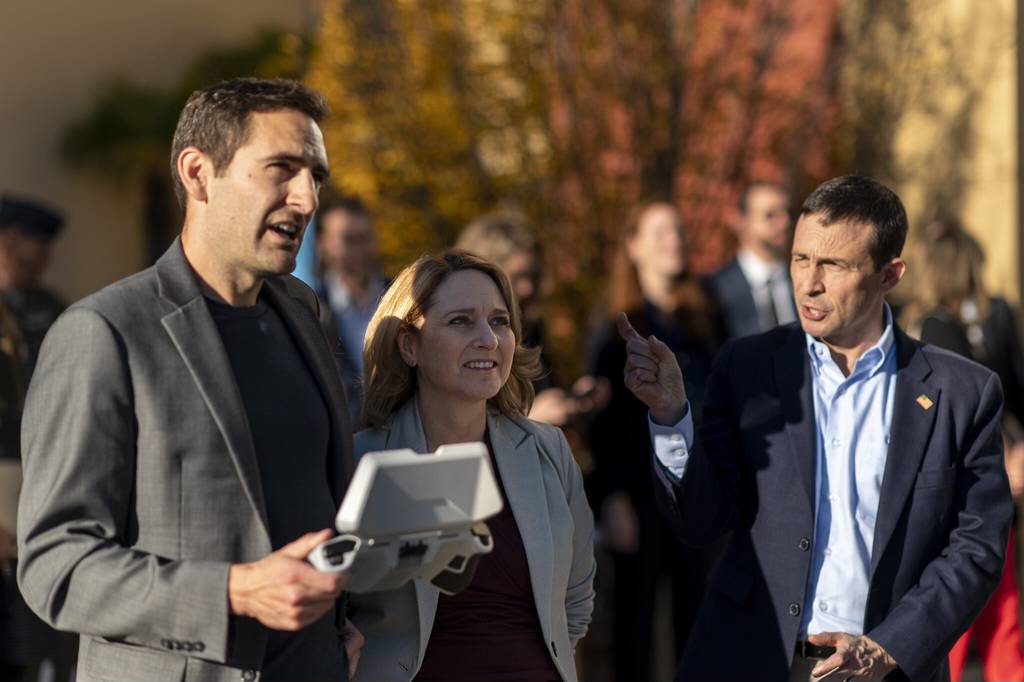Editor’s note: An earlier version of this story incorrectly described the technology Pentagon leaders saw during a visit to Kodiak Robotics.
WASHINGTON — Nine companies got a meeting. Two companies got site visits. But very few of the industry executives who spoke with Deputy Secretary of Defense Kathleen Hicks last week said they got answers.
This was the takeaway from last week’s round of meetings on Replicator, Hicks’ pledge to field thousands of drones within two years to help defend Taiwan. Two weeks after a similar visit from Secretary of Defense Lloyd Austin, she traveled to the Defense Innovation Unit in Mountain View, California and spoke with around 10 companies’ executives.
Defense News spoke with seven of the industry executives in attendance. Most said they arrived looking for more detail on Replicator. Instead, Pentagon officials wanted more details from them.
“It was more for them to hear how we are thinking about things,” said Brandon Tseng, chief executive of Shield AI, a drone maker represented at the meeting.
Almost four months into the initiative, many executives have basic questions about how Replicator will work. Companies want to know how to apply, how it will be funded, what systems the Pentagon will want and how many.
Many stressed their questions shouldn’t be taken as criticisms. Each company that spoke with Defense News said they still wanted to be a part of Replicator and were excited by the program.
“The theme from the room is frankly that Replicator is still underspecified,” said Peter Ludwig, the chief technology officer of the software company Applied Intuition. Ludwig said Pentagon officials at the meeting promised to release later this month a memo with more details on the project.
Speaking with reporters at a breakfast in mid-November, Hicks said the Pentagon would choose its first batch of Replicator systems in early December.
Executives from the ground robotics company RRAI and drone manufacturer BRINC said they were told by a DIU official during the visit the first group of systems for Replicator have already been chosen and the services would announce them in January, if not earlier.
The Pentagon declined to say whether it has made selections.
After the meeting, Hicks visited two other companies — Skydio, a U.S. drone manufacturer, and Kodiak Robotics, a company developing autonomous technology for the long-haul trucking industry.
Don Burnette, chief executive of Kodiak Robotics, said Hicks saw a demonstration of the company’s first military test vehicle — a Ford F-150 equipped with autonomy hardware and software that allow it to operate in complex military environments. She also took a ride in one of the company’s semi-trucks fitted with similar technology.
“We spent a half an hour together just one on one talking strategy, talking capabilities,” he told Defense News. “She got to see the technology with her own eyes, which I think is really important.”
At Skydio, Hicks saw a demonstration of the company’s X10D, a small drone designed for military missions. Skydio also showed Hicks its collaborative autonomy technology, which it developed through a partnership with the Defense Innovation Unit.
Mark Valentine, president of Skydio’s global government business, said Hicks was interested in the company’s approach to scaling drone production and wanted to better understand the associated challenges.
“She is clearly deep in the issue, and I think that’s important,” Valentine said. “When you have focus on that level, that’s how you get things done.”
Many in industry interested in Replicator want to know what the Pentagon wants from them. In particular, they are seeking two things: details on which capabilities DoD will buy first or at least a more specific description of what systems are in play.
“We can scale [up] production,” said Blake Resnick, chief executive of BRINC. “But we can’t spend $10 or $100 million on a factory in order to build a DoD product, if the DoD is not writing orders.”
Other companies who met with Hicks included Saronic, Anduril, AeroVironment, SiMa.ai, Divergent 3D and Stell Engineering.
Courtney Albon is C4ISRNET’s space and emerging technology reporter. She has covered the U.S. military since 2012, with a focus on the Air Force and Space Force. She has reported on some of the Defense Department’s most significant acquisition, budget and policy challenges.
Noah Robertson is the Pentagon reporter at Defense News. He previously covered national security for the Christian Science Monitor. He holds a bachelor’s degree in English and government from the College of William & Mary in his hometown of Williamsburg, Virginia.








